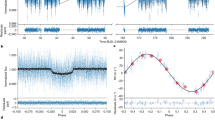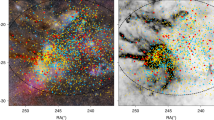Abstract
The abundance of heavy elements (metallicity) in the photospheres of stars similar to the Sun provides a ‘fossil’ record of the chemical composition of the initial protoplanetary disk. Metal-rich stars are much more likely to harbour gas giant planets1,2,3,4, supporting the model that planets form by accumulation of dust and ice particles5. Recent ground-based surveys suggest that this correlation is weakened for Neptunian-sized planets4,6,7,8,9. However, how the relationship between size and metallicity extends into the regime of terrestrial-sized exoplanets is unknown. Here we report spectroscopic metallicities of the host stars of 226 small exoplanet candidates discovered by NASA’s Kepler mission10, including objects that are comparable in size to the terrestrial planets in the Solar System. We find that planets with radii less than four Earth radii form around host stars with a wide range of metallicities (but on average a metallicity close to that of the Sun), whereas large planets preferentially form around stars with higher metallicities. This observation suggests that terrestrial planets may be widespread in the disk of the Galaxy, with no special requirement of enhanced metallicity for their formation.
This is a preview of subscription content, access via your institution
Access options
Subscribe to this journal
Receive 51 print issues and online access
$199.00 per year
only $3.90 per issue
Buy this article
- Purchase on Springer Link
- Instant access to full article PDF
Prices may be subject to local taxes which are calculated during checkout



Similar content being viewed by others
References
Santos, N. C., Israelian, G. & Mayor, M. Spectroscopic [Fe/H] for 98 extra-solar planet-host stars. Exploring the probability of planet formation. Astron. Astrophys. 415, 1153–1166 (2004)
Fischer, D. A. & Valenti, J. The planet-metallicity correlation. Astrophys. J. 622, 1102–1117 (2005)
Johnson, J. A., Aller, K. M., Howard, A. W. & Crepp, J. R. Giant planet occurrence in the stellar mass-metallicity plane. Publ. Astron. Soc. Pacif. 122, 905–915 (2010)
Sousa, S. G., Santos, N. C., Israelian, G., Mayor, M. & Udry, S. Spectroscopic stellar parameters for 582 FGK stars in the HARPS volume-limited sample. Revising the metallicity-planet correlation. Astron. Astrophys. 533, A141 (2011)
Pollack, J. B. et al. Formation of the giant planets by concurrent accretion of solids and gas. Icarus 124, 62–85 (1996)
Udry, S. et al. The HARPS search for southern extra-solar planets. V. A 14 Earth-masses planet orbiting HD 4308. Astron. Astrophys. 447, 361–367 (2006)
Sousa, S. G. et al. Spectroscopic parameters for 451 stars in the HARPS GTO planet search program. Stellar [Fe/H] and the frequency of exo-Neptunes. Astron. Astrophys. 487, 373–381 (2008)
Ghezzi, L. et al. Stellar parameters and metallicities of stars hosting Jovian and Neptunian mass planets: a possible dependence of planetary mass on metallicity. Astrophys. J. 720, 1290–1302 (2010)
Mayor, M. et al. The HARPS search for southern extra-solar planets XXXIV. Occurrence, mass distribution and orbital properties of super-Earths and Neptune-mass planets. Preprint at http://arxiv.org/abs/1109.2497 (2011)
Borucki, W. J. et al. Kepler planet-detection mission: introduction and first results. Science 327, 977–980 (2010)
Borucki, W. J. et al. Characteristics of planetary candidates observed by Kepler. II. Analysis of the first four months of data. Astrophys. J. 736, 19–41 (2011)
Yi, S. et al. Toward better age estimates for stellar populations: the Y2 isochrones for solar mixture. Astrophys. J. Suppl. Ser. 136, 417–437 (2001)
Schlaufman, K. C. & Laughlin, G. Kepler exoplanet candidate host stars are preferentially metal rich. Astrophys. J. 738, 177–186 (2011)
Lissauer, J. J. et al. A closely packed system of low-mass, low-density planets transiting Kepler-11. Nature 470, 53–58 (2011)
Haisch, K. E., Lada, E. A. & Lada, C. J. Disk frequencies and lifetimes in young clusters. Astrophys. J. 553, L153–L156 (2001)
Ida, S. & Lin, D. N. C. Toward a deterministic model of planetary formation. II. The formation and retention of gas giant planets around stars with a range of metallicities. Astrophys. J. 616, 567–572 (2004)
Throop, H. B. & Bally, J. Can photoevaporation trigger planetesimal formation? Astrophys. J. 623, L149–L152 (2005)
Johansen, A., Youdin, A. & Mac Low, M.-M. Particle clumping and planetesimal formation depend strongly on metallicity. Astrophys. J. 704, L75–L79 (2009)
Ercolano, B. & Clarke, C. J. Metallicity, planet formation and disc lifetimes. Mon. Not. R. Astron. Soc. 402, 2735–2743 (2010)
Yasui, C., Kobayashi, N., Tokunaga, A. T., Saito, M. & Tokoku, C. Short lifetime of protoplanetary disks in low-metallicity environments. Astrophys. J. 723, L113–L116 (2010)
Lin, D. N. C., Bodenheimer, P. & Richardson, D. C. Orbital migration of the planetary companion of 51 Pegasi to its present location. Nature 380, 606–607 (1996)
Gorti, U. & Hollenbach, D. Photoevaporation of circumstellar disks by far-ultraviolet, extreme-ultraviolet and X-ray radiation from the central star. Astrophys. J. 690, 1539–1552 (2009)
Hester, J. J., Desch, S. J., Healy, K. R. & Leshin, L. A. The cradle of the Solar System. Science 304, 1116–1117 (2004)
Schiller, M. et al. Rapid timescales for magma ocean crystallization on the howardite-eucrite-diogenite parent body. Astrophys. J. 740, L22–L28 (2011)
Gonzalez, G., Brownlee, D. & Ward, P. The galactic habitable zone: galactic chemical evolution. Icarus 152, 185–200 (2001)
Morton, T. D. & Johnson, J. A. On the low false positive probabilities of Kepler planet candidates. Astrophys. J. 738, 170–182 (2011)
Howard, A. W. et al. Planet occurrence within 0.25 AU of Solar-type stars from Kepler. Preprint at http://arxiv.org/abs/1103.2541 (2011)
Acknowledgements
The Kepler mission was competitively selected as the tenth NASA Discovery mission. Funding for this mission is provided by NASA’s Science Mission Directorate. The Centre for Star and Planet Formation is funded by the Danish National Research Foundation. L.A.B. was funded by the Carlsberg Foundation. A.J. was partially funded by the European Research Council under ERC Starting Grant agreement 278675-PEBBLE2PLANET.
Author information
Authors and Affiliations
Contributions
L.A.B. led the project and developed the classification tools for the metallicity analysis. D.W.L., A.J. and M.B. contributed to the discussion of the theoretical implications of the data. G.T. supplied the isochrone fitting tools. J.F.R. provided the planet radii from the Kepler photometry. D.W.L., C.C., W.D.C., G.A.E., E.B., M.E., J.C.G., T.H., G.W.M., P.R., R.P.S. and S.N.Q. worked on gathering the spectroscopic observations. D.W.L., W.J.B., S.T.B., N.M.B., D.R.C., W.D.C., R.L.G., P.W.L., G.W.M., A.S., M.S., H.I., E.B.F. and S.N.Q. worked on identifying the Kepler planets and eliminating false positives. W.J.B. led the Kepler mission. J.B.L., J.A.M. and D.W.L. worked on the synthetic stellar model library. All authors discussed the results and commented on the manuscript. L.A.B. wrote the paper with equal input from D.W.L., A.J. and M.B.
Corresponding author
Ethics declarations
Competing interests
The authors declare no competing financial interests.
Supplementary information
This file contains Supplementary Figures 1-7 and Supplementary Tables 1-4.
This file contains Supplementary Figures 1-7 and Supplementary Tables 1-4. This file contains Supplementary Text 1-5, Supplementary Figures 1-3, Supplementary References and Supplementary Table 1. Please note that the file, which provides the ASCII text version of the extracted wavelength and calibrated spectra used in the analysis, is available at the following link: http://exoplanets.dk/data/Nature/Kepler_metal_spectra_coadd.txt (PDF 404 kb)
Rights and permissions
About this article
Cite this article
Buchhave, L., Latham, D., Johansen, A. et al. An abundance of small exoplanets around stars with a wide range of metallicities. Nature 486, 375–377 (2012). https://doi.org/10.1038/nature11121
Received:
Accepted:
Published:
Issue Date:
DOI: https://doi.org/10.1038/nature11121
This article is cited by
-
The evolution of CNO elements in galaxies
The Astronomy and Astrophysics Review (2022)
-
An ultrahot Neptune in the Neptune desert
Nature Astronomy (2020)
-
A giant impact as the likely origin of different twins in the Kepler-107 exoplanet system
Nature Astronomy (2019)
Comments
By submitting a comment you agree to abide by our Terms and Community Guidelines. If you find something abusive or that does not comply with our terms or guidelines please flag it as inappropriate.



